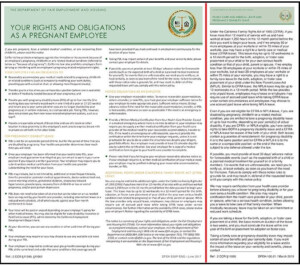 The New Parent Leave Act (NPLA) – What’s New?
The New Parent Leave Act (NPLA) – What’s New?
For just over a year now, new parents in California who work for small employers have been exercising the same right to take child-bonding leave that new parents employed by large employers have enjoyed for the last twenty-five years. California’s New Parent Leave Act (NPLA), which permits employees of small employers to take parental leave, went into effect on January 1, 2018. The regulations implementing the NPLA and formalizing NPLA employee notice requirements were approved on February 27, 2019 and take effect on April 1, 2019.
NPLA – What’s It About?
The NPLA requires employers with 20 or more employees to provide eligible employees with up to 12 weeks of job-protected leave to bond with a new child within one year of the child’s birth, adoption, or foster care placement with the employee. The NPLA is similar to the California Family Rights Act (CFRA) which guarantees employees working for employers with 50 or more employees up to 12 weeks of child-bonding leave.
Who is Eligible for NPLA Leave?
To be NPLA-eligible, the employee must have more than 12 months of service with the employer, have at least 1,250 hours of service with the employer during the previous 12-month period, and work at a worksite from which the employer employs at least 20 employees within a 75-mile radius. Both mothers and fathers may take NPLA leave. Both full-time and part-time employees are eligible for NPLA leave.
Do Employees Get Paid While on Leave?
Although NPLA leave is unpaid, employees on NPLA leave may use accrued vacation pay, paid sick time, other accrued paid time off, or other paid or unpaid time off provided by the employer. Employees may be eligible for partial wage replacement while on NPLA leave through California’s Paid Family Leave program (PFL). Also, an employee may take NPLA leave in addition to paid Pregnancy Disability Leave (PDL), if eligible.
What are Employers’ Responsibilities?
The law requires an employer to maintain coverage of an employee on NPLA leave under the employer’s group health plan. At the end of NPLA leave, the employer must reinstate the employee to the same job or a comparable one. A comparable job is one that is the same or similar in terms of pay, duties, and location. The law prohibits an employer from interfering with or denying an eligible employee NPLA leave and from retaliating or discriminating against an employee for exercising their NPLA leave rights.
NPLA Posting Compliance
The NPLA regulations require employers to post a notice in the workplace explaining NPLA rights and obligations. The California Department of Fair Employment and Housing (DFEH) has revised the official “Family Care and Medical Leave and Pregnancy Disability Leave” notice to include provisions of the NPLA. The notice must be posted prominently where it can be readily seen by employees and applicants for employment. If 10% or more of the employer’s workforce at any given location speaks a language other than English, then the employer is required to post the notice in such other languages. Employers are also required to incorporate a description of NPLA leave in the next printing of their employee handbooks.
We have created the DFEH’s Family Care and Medical Leave and Pregnancy Disability Leave Peel ‘N Post™ update sticker for employers that already have a California All-On-One Labor Law Poster™ or Mobile Poster Pak™. The Peel ‘N Post update sticker neatly covers the outdated notice on the poster, ensuring posting compliance with a minimum of expense and effort. Employers can also purchase a new California All-On-One Labor Law Poster or Mobile Poster Pak both of which have been updated with the DFEH’s revised notice. Our Peel ‘N Post update stickers, All-On-One Posters and Mobile Poster Paks are available in English and Spanish.
|
|

